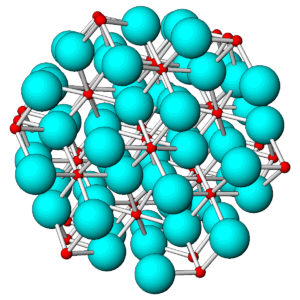4.4.3: Organized Atomic Arrangements
- Page ID
- 19139
Because like charges repel and opposite charges attract, as atoms come together to form crystals, cations bond to, and are surrounded by, anions. Anions bond to, and are surrounded by, cations. This occurs even if bonding is not entirely ionic. So, crystal structures generally consist of alternating cations and anions in three dimensions. These charge balance considerations are the reasons that ideal crystals have an ordered atomic arrangement. The distribution of ions is the same in all parts of the crystal and does not depend on crystal size. If more than one arrangement is possible, crystals will naturally grow in the way that minimizes energy.

Most common anions such as O2-, are larger than common cations. So, we can think of ionic mineral structures as involving small cations (shown in red) surrounded by larger anions (shown in blue). The number of cations around each anion depends primarily on their relative sizes. In this figure, which is based on the atomic arrangement in corundum, six anions bond to each cation, and four cations bond to each anion. In other minerals, cations and anions may have fewer or a greater number of bonds than this.


